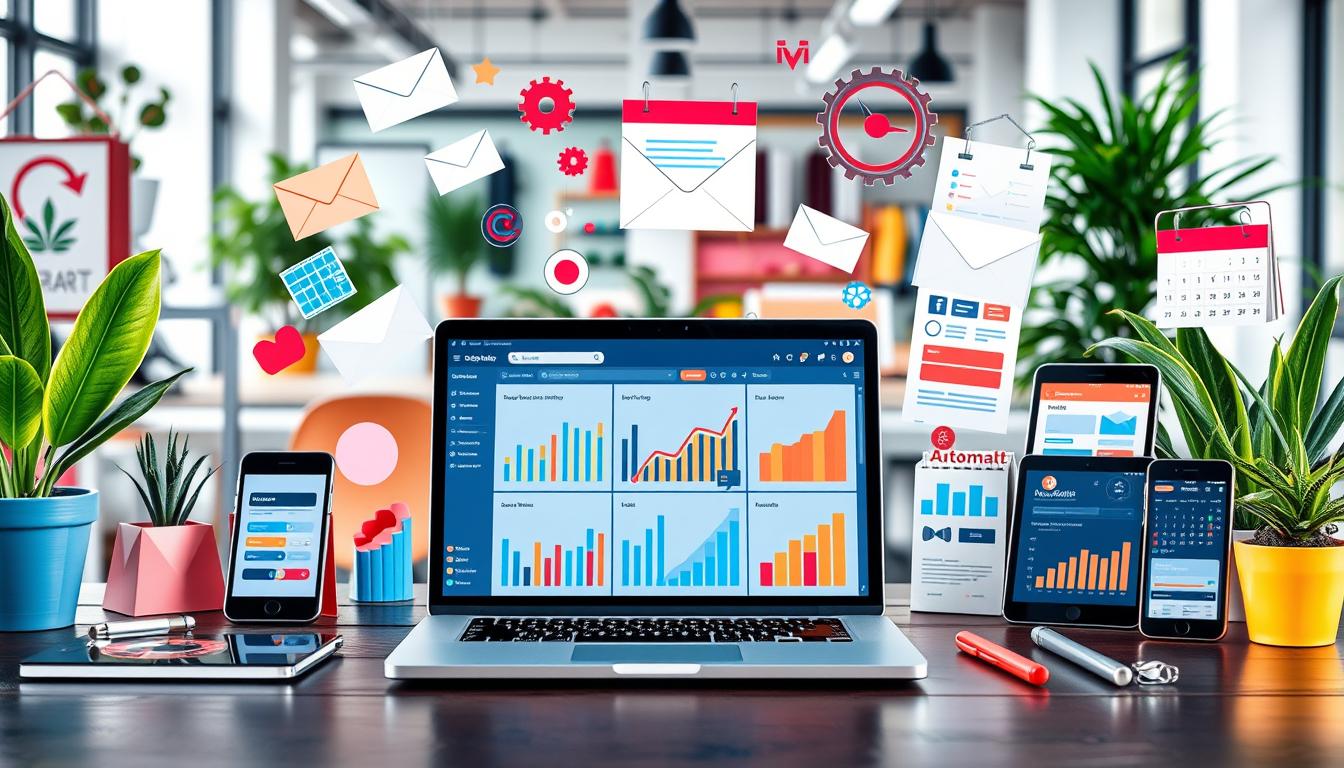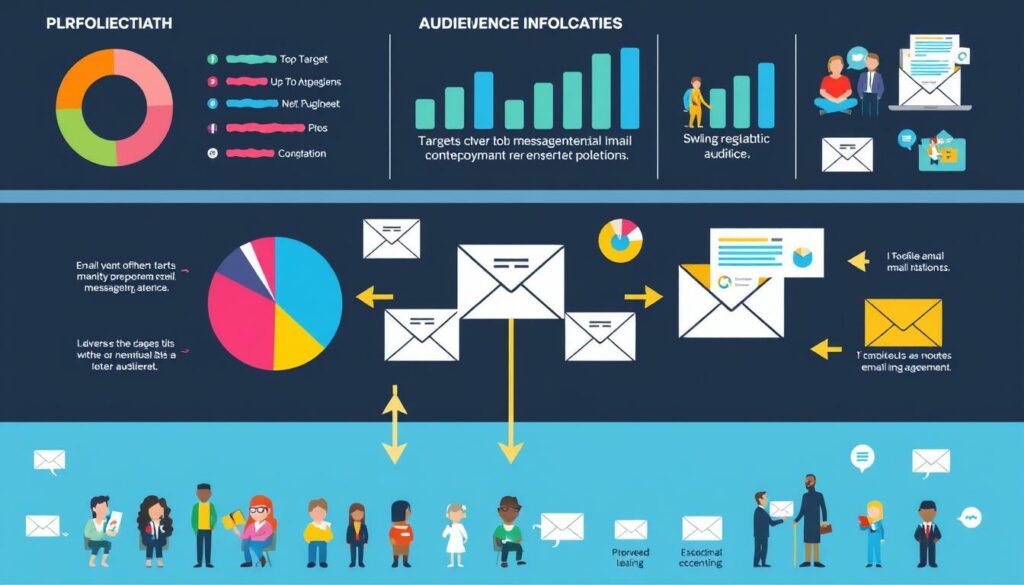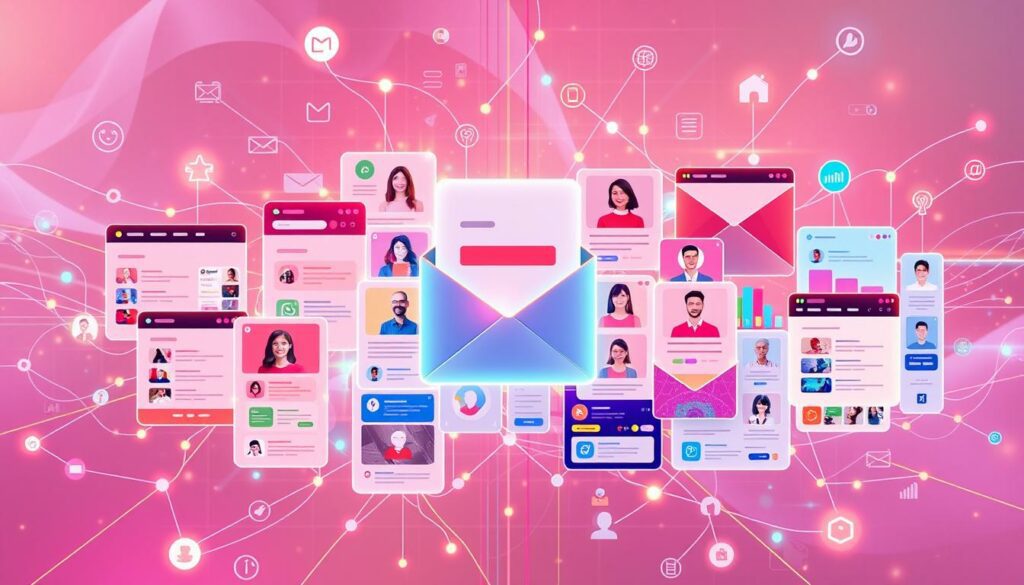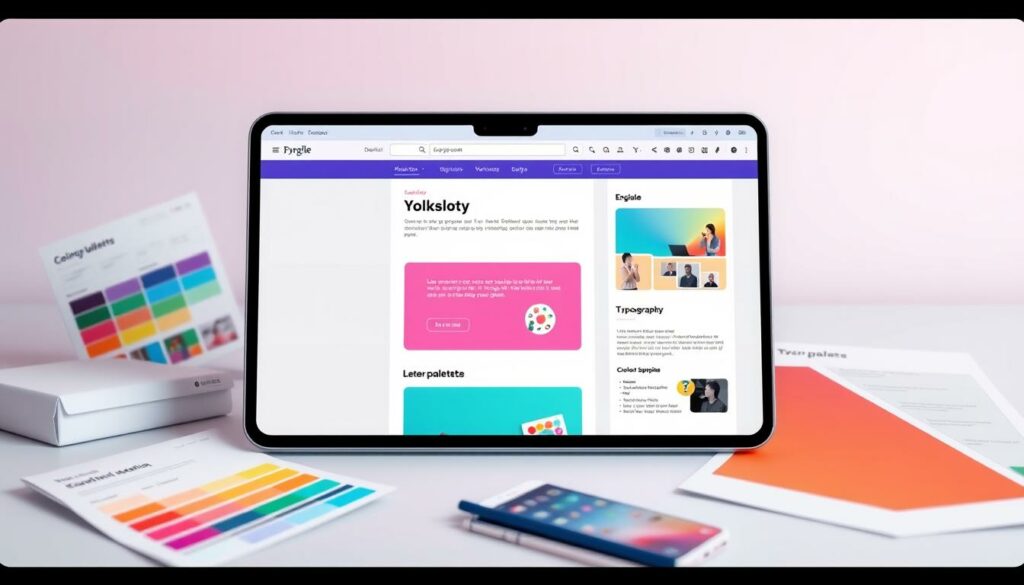Best Practices for Email Marketing in 2024

Table of Contents
Did you know that in 2024, email marketing is still key for getting new customers? It plays a big role in many industries’ success1. To succeed, it’s crucial to know the best ways to use email marketing. This helps increase engagement and get more people to take action2.
As digital tools get better, it’s important to keep up with the latest trends. This way, your emails will not only get to your audience but also connect with them deeply3. In this article, I’ll share the top tips for improving your email marketing in 2024. We’ll focus on making emails personal, segmenting well, and having a strong call to action.
Key Takeaways
- Email marketing is crucial for customer acquisition and engagement.
- Utilizing A/B testing optimizes performance for elements like subject lines and CTAs.
- Segmentation enhances personalized communication, leading to better engagement.
- Mobile optimization is vital due to the increasing smartphone usage.
- Compliance with email marketing laws is essential to maintain a healthy subscriber base.
Understanding Email Marketing and Its Importance
Email marketing is a key part of digital marketing. It lets businesses talk directly to customers through emails. The first email campaign in 1978 by Gary Thuerk made $13 million, showing email’s power4.
Now, 333 billion emails are sent every day. This number is expected to grow to 392.5 billion by 20264. Email marketing’s ROI is impressive, with an average of $36 for every $1 spent5. Retail and consumer goods see even better returns, with an ROI of $45 for each dollar5.
Learning about email marketing’s cost-effective strategies can boost a business’s communication. Branded emails have an average open rate of 21.33 percent, offering a big chance for engagement5. In today’s world, where clear communication is key, using email marketing can help build stronger customer ties and boost profits.
Get to Know Your Audience
Understanding my audience is key to making my email marketing work. Without knowing my customer understanding, I might waste a lot of money. For example, $37 billion is lost each year on ads that don’t reach their target6. By getting to know my audience better, I can make my campaigns more effective.
It’s important to know what my audience likes to hear. Eighty percent of people say they’re more likely to engage with a brand if it talks to them personally6. This shows how crucial it is to send messages that really speak to my audience’s needs and interests.
To get better at this, I create buyer personas. I find it helpful to stick to three to five personas, based on things like age, gender, and where they live6. This method helps me understand my audience better and make my messages more relevant.
The steps I take to figure out who my audience is include:
- Analyzing my customer base
- Conducting market research
- Studying competitors
- Creating well-defined personas
- Identifying groups that do not fit my target audience
- Continuously revising these personas based on new data
Using tools like Google Analytics helps me get the audience insights I need. By watching how people visit my site, I can make my email marketing better. This focus on understanding my audience is crucial for my business to grow and for improving the customer experience7.

Segmentation: Tailoring Your Message
Effective email marketing depends on email segmentation. It lets me send targeted messaging that speaks to my audience. By knowing who my customers are and what they do, I can make content that really speaks to them. This leads to better engagement and more sales.
Demographic-Based Segmentation
Demographic segmentation looks at things like age, gender, and income. When I tailor my messages to these groups, my campaigns become more relevant. This approach boosts customer engagement and builds stronger, more loyal relationships8.
Accenture found that 91% of shoppers prefer brands that offer relevant deals. This shows how important it is to use customer demographics in my marketing9.
Behavioral Segmentation
Behavioral segmentation looks at what people do, like what they buy and how they interact with my site. This lets me send more personalized emails, which can lead to more sales and better campaign results8.
Personalized emails can increase revenue by 10 to 15%9. Predictive segmentation also helps me guess what customers might want next. This makes my marketing efforts even more effective9.
By improving my segmentation, I can see a huge jump in revenue. Segmented campaigns can see up to a 760% increase, according to DMA research9.

Personalization: The Key to Engagement
In email marketing, personalization is key for better engagement. Using customer data, I can make emails that fit each person’s taste. This makes my emails more relevant and effective.
71% of people want personalized interactions, and 76% get upset if they don’t get them10. Companies that do well with personalization make 40% more money than others10. So, it’s important to get better at using data.
Utilizing Customer Data
Using customer data helps me send messages that really speak to my audience. I look at things like demographics, what they’ve bought, and what they like. This helps me make personalized suggestions that boost sales11.
Now, over 70% of people see personalization as a must-have10. To stay ahead, I need to meet this expectation.
A/B Testing Your Content
A/B testing is a big help in making emails better. It lets me see which versions of my emails work best. This way, I can make my emails more engaging.
For example, changing the subject line or how the content is laid out can really help11. McKinsey found that personalized experiences can make customers spend 10-15% more12. This ongoing improvement helps keep my emails relevant and builds stronger relationships with customers.

Crafting Compelling Subject Lines
Creating effective subject lines is key to boosting email engagement and open rates. Studies show that personalized subject lines do better than generic ones, leading to more opens13. Good subject lines grab attention, are short, and relevant. Using emojis can make emails stand out, boosting open rates13.
When you send emails matters a lot. Mondays are the best day for open rates, at 22.0%, while Sundays are the worst at 20.3%14. Also, emails sent in mid-mornings on weekdays get more opens13. A/B testing can help find the best subject lines by comparing different versions13.

Adding a sense of urgency and exclusivity to subject lines can prompt quick action. The highest click-through rates happen on Tuesdays at 2.4%, while weekends have the lowest engagement14. Knowing these details helps improve my email marketing by making subject lines that grab attention and meet the audience’s interests.
Timing Your Emails for Maximum Impact
Effective email marketing depends a lot on email timing. Knowing when your subscribers are most active can boost engagement rates. Studies show that B2B folks engage more on weekdays, especially Tuesday to Thursday. The best times to send emails are around 9am to 11am for the highest open and click-through rates1516.
Don’t send emails on Mondays or Fridays to B2B clients. These days are often filled with catching up and winding down. Instead, try sending emails from 12pm to 1pm when people take their lunch break15.
For B2C audiences, late afternoons and weekends are better. Friday afternoons are especially good for getting people ready for the weekend1517. Also, 23% of emails are opened within an hour of sending, showing the importance of timing16. Weekends, especially Saturdays and Sundays, have much higher open rates, showing great potential for engagement17.
To get the best engagement rates, test different times to find what works best for your audience. Tailoring your timing to your recipients’ demographics and time zones can also help. Being flexible and adjusting your strategies is key16.
| Day | Open Rate (%) |
|---|---|
| Monday | 13.1 |
| Tuesday | 13.4 |
| Wednesday | 12.9 |
| Thursday | 12.4 |
| Friday | 12.7 |
| Saturday | 16.9 |
| Sunday | 18.7 |
Designing Visually Appealing Emails
A well-crafted email design grabs attention and engages the audience. Using responsive templates is key to ensure content looks great on all devices. Since most emails are opened on mobiles, making designs flexible for different screens is vital18.
Responsive Email Design
Responsive email design is a must in today’s world. Emails should look and work well on both desktops and smartphones. Email marketing is seen as the 5th most effective digital marketing channel19.
By using high-quality images and keeping layouts simple, I can make emails that are both attractive and easy to use18.
Utilizing Colors and Images Effectively
Colors are crucial in visual marketing. Research shows that color is key when choosing everyday items19. Warm colors create urgency, while cool colors build trust18.
Using contrasting colors helps highlight different parts of an email, guiding the reader’s focus20. Adding textures and real images makes the brand feel more real20.

Beautiful emails, with the right mix of visuals, lead to better engagement and message retention. The right mix of color psychology and responsive templates boosts an email campaign’s success19. By knowing my audience and using these strategies, I can create impactful email designs18.
Creating a Clear Call to Action (CTA)
In email marketing, a clear call to action (CTA) is key. It guides subscribers to take action. Studies show emails with a single CTA can see a 371% jump in clicks and a 1617% rise in sales21. Each email should clearly state its goal, whether it’s to buy, sign up, or engage more.
Using effective CTAs is crucial in my email strategy. A well-placed CTA can boost blog post revenue by up to 83%21. CTAs that create a sense of urgency can significantly increase clicks and conversions21. Adding pricing info in CTAs can also lead to quicker decisions.
It’s also vital to tailor CTAs for different devices for better engagement and conversions21. A good CTA can simplify decisions and add value to emails22. Emails can convert up to 15% if done right22. Testing different CTAs helps find what works best.

| CTA Type | Common Verbs | Conversion Focus |
|---|---|---|
| Ecommerce | Buy, Shop, Order | Increasing Sales |
| SaaS | Try, Get Started, Subscribe | User Acquisition |
| Non-Profit | Donate, Volunteer, Support | Awareness and Action |
| Community | Join, Sign Up, Refer | Building Engagement |
| Freebies | Download, Claim, Get | Lead Generation |
| General | Learn More, Click Here, Start | Information Dissemination |
Using strong action words and emotions makes CTAs more effective. Surrounding text should reduce distractions and ease hesitation. This deepens the impact of my calls to action, boosting my email campaign’s success rate.
Measuring Your Email Marketing Success
In the competitive world of email marketing, it’s crucial to measure success. I focus on key email metrics to see how well my campaigns are doing. By tracking these metrics, I can make smart decisions to improve my strategies.
Key Metrics to Track
Choosing the right metrics is key to analyzing performance. Here are some important ones:
- Open Rate: This shows how many emails were opened compared to how many were sent. It helps me see if people are interested23.
- Click Rate: This tells me how many people clicked on links in my emails. It shows how engaged they are23.
- Conversion Rate: This is how many people took the action I wanted them to. It’s a key measure of success24.
- Bounce Rate: This helps me see if emails are getting delivered. It includes both hard and soft bounces23.
- Email List Growth Rate: This shows how fast my email list is growing. It’s calculated by new subscribers minus unsubscribes, divided by total subscribers25.
- Spam Complaint Rate: This tells me if people are marking my emails as spam. It helps keep my sender reputation good23.
Leveraging Analytics for Improvement
Analytics tools turn data into useful insights. They help me see what’s working and what’s not. For example:
| Metric | Calculation Formula | Importance |
|---|---|---|
| Clickthrough Rate | (Total clicks ÷ Number of delivered emails) * 100 | Shows how well people are engaging with my emails24. |
| Open Rate | (Number of emails opened ÷ Total emails delivered) * 100 | Indicates if people are interested in my emails24. |
| ROI | ((Revenue – Costs) ÷ Costs) * 100 | Measures the financial success of my email campaigns25. |
By tracking these metrics and making adjustments, I can improve my email marketing. This leads to better results and more engagement.
Effective Use of Automation in Email Marketing
In today’s fast world, email automation is key for better workflow efficiency and more relevant messages. Research shows that 90% of people like personalized content, making it vital for keeping them engaged26. Sending welcome messages through automation can lead to four times more reads and five times more clicks than regular emails, showing its power26.
Automated workflows change how I connect with potential customers. For example, drip campaigns with the right content keep prospects interested. This way, I can keep in touch without losing the personal touch my audience wants27. Also, about 70% of online shoppers leave their carts behind, making quick follow-ups with automation crucial for getting them back26.
Using marketing tools for email automation boosts customer interaction. Since 99% of people check their email every day, it’s a great way to stay in touch28. Automation lets me send campaigns that really speak to my audience, making each message count28.
When setting up these automated systems, it’s important to have clear goals. This helps measure how well each campaign does, whether it’s for subscriptions, donations, or other actions27. With good planning and the right tools, I can see a big jump in conversions.
| Aspect | Importance | Statistical Insight |
|---|---|---|
| Email Automation | Enhances engagement and efficiency | 4.4 billion users worldwide28 |
| Personalized Messaging | Increases consumer interest | 90% find it appealing26 |
| Cart Recovery | Reduces abandonment rates | 70% of e-commerce shoppers abandon carts26 |
| Automated Workflows | Boosts productivity and effectiveness | Overhead decreases, savings enhance27 |
Best Practices for Email Frequency and Timing
Finding the right email frequency is key to keeping my audience engaged. Too many emails can lead to subscriber fatigue and high unsubscribe rates. A HubSpot survey shows 95% of marketers found email marketing effective in 202129.
Not emailing enough can make subscribers lose interest. They expect regular updates. Infrequent emails also make it harder for them to recognize my brand30.
Keeping my brand in mind is crucial. The timing of my emails is also important. Emails sent on Mondays, Tuesdays, and Wednesdays get the most engagement29.
Sending emails between 9 a.m. and 12 p.m. on Tuesdays can boost interaction. Finding the right frequency is a challenge that requires adjusting based on audience feedback29.
Too many emails can make people ignore or mark them as spam. This hurts my sender reputation. Over-sending can also lower sales and revenue by missing opportunities29.
Testing different email frequencies can help find the right balance. Tracking open and click-through rates is also important for understanding engagement31. Using these strategies keeps my email marketing effective and engaging.
Building Your Email List Organically
Building a strong email list is key to any good marketing plan. I focus on growing my list naturally, which means getting people who really want to hear from me. It’s important to get people to opt in the right way to keep trust and follow the rules.
Avoiding Bought Lists
Buying email lists might seem easy, but it usually leads to low engagement and lots of people unsubscribing. It’s much cheaper to keep a customer than to get a new one32. So, I use different ways to get people to sign up for real. Things like eBooks or special group access can really get people excited33.
Almost 95% of people are more likely to buy something if it’s personalized, not generic33. This shows how important it is to treat each subscriber as an individual. Also, adding a sign-up button to forwarded emails can catch people who got my emails from others33.
To grow my list naturally, I ask my subscribers to share my content with their friends. Using referral programs to reward them is another great way to get more people on my list32. It’s clear that growing my list the right way not only makes it bigger but also builds a loyal group of people who really care about what I offer.
Marketing Strategies for Different Holidays
When it comes to holiday marketing, creating strategies for each holiday is key. Seasonal promotions boost customer engagement during busy shopping times. It’s important to send out email campaigns that match consumer behavior and seasonal trends.
Special Offers and Promotions
Creating special offers grabs customers’ attention during the holidays. For example, 50% of people start shopping before Halloween, showing the need for early marketing34. Using loyalty programs can also increase spending, with offers like a 10% off coupon encouraging repeat business34.
Also, 75% of millennials’ buying decisions are swayed by a brand’s social media, making social media crucial during holidays35. Special deals can highlight what makes your business unique, especially on Small Business Saturday34.
Email marketing is also key in driving sales. Customers respond well to timely promotions. It’s important to avoid false urgency and focus on real incentives to encourage buying35. Adding video marketing to campaigns is also beneficial, as 90% of users say it helps in making buying decisions34.
With winter holiday online sales hitting $276.8 billion in 2023, the chance to boost sales through holiday strategies is clear36. Knowing your customers well is essential for crafting messages that resonate, especially during this competitive time35.
| Strategy | Description | Impact |
|---|---|---|
| Seasonal Promotions | Targeted offers during peak shopping times. | Increased sales and customer engagement. |
| Loyalty Programs | Encouragement of repeat purchases through discounts. | Higher purchase volume and brand loyalty. |
| Email Campaigns | Well-timed messages that drive sales. | Improved conversion rates and customer interest. |
| Social Media Engagement | Influencing purchasing decisions through targeted marketing. | Enhanced brand visibility and customer interaction. |
Conclusion
Looking back at this email marketing guide, it’s clear that keeping up with new trends is key for success in 2024. Using strategies like segmentation, personalization, and good design can boost my email campaigns. These tips will help me keep my emails relevant and effective.
Good email marketing needs a solid plan that uses the best practices we’ve seen. Just like a strong start and end in writing, great subject lines and clear calls to action are crucial. Using real-time data and designs that work on all devices helps me stay connected with my subscribers.
Keeping my messages personal is vital for building strong connections with my audience. I aim to create emails that grab attention and encourage more interaction. By using these insights, I’m dedicated to finding new ways to communicate and engage through email marketing and more3738.
FAQ
What is the importance of email marketing in 2024?
Email marketing is still a key digital strategy. It’s a cost-effective way to communicate with people. With an average ROI of 4,400%, it’s great for getting new customers and keeping them engaged.
How can I improve my email engagement rates?
To get more people to engage with your emails, make them personal. Use data and behavior to tailor your messages. This makes your emails more relevant and boosts open and click-through rates.
What are some key metrics I should track for email marketing success?
Keep an eye on open rates, click-through rates, unsubscribe rates, and conversion rates. These metrics help you understand how well your emails are doing. Use this info to make your future campaigns better.
How often should I send emails to my subscribers?
It’s important to find the right email frequency. Sending emails too often can make people tired and want to unsubscribe. Aim for a balance that keeps your subscribers interested without being too much.
What role does segmentation play in email marketing?
Segmentation helps you send emails that are more relevant to your audience. By grouping people based on who they are and what they do, you can make your emails more effective. This leads to better engagement and higher conversion rates.
Why is A/B testing important in email marketing?
A/B testing lets you try different things to see what works best. You can test subject lines, content, and calls to action. This helps you make your emails better and get more responses.
How can I ensure my emails are mobile-friendly?
Use responsive design to make sure your emails look good on any device. This ensures that your emails are easy to read and look great, whether on a phone, tablet, or computer.
What should I include in my call to action (CTA)?
Your call to action should be clear and compelling. It should tell your subscribers what you want them to do. Make sure it stands out and encourages them to take action right away.
How do seasonal marketing strategies impact email campaigns?
Using seasonal marketing can really boost your email campaigns. Create special offers that fit the holiday spirit. This can grab your customers’ attention and increase sales.
How can I build my email list organically?
To grow your email list naturally, focus on getting people to sign up willingly. Offer something in return for their email address. Avoid buying lists to keep your subscribers engaged and to follow the rules.
Source Links
- https://sendgrid.com/en-us/resource/email-marketing-best-practices-tips
- https://www.salesforce.com/marketing/email/best-practices/
- https://www.forbes.com/advisor/business/software/email-marketing-strategy/
- https://mailchimp.com/marketing-glossary/email-marketing/
- https://www.coursera.org/articles/email-marketing
- https://www.marketingevolution.com/marketing-essentials/target-audience
- https://blog.hubspot.com/service/know-your-audience
- https://technologytherapy.com/tailoring-your-message-the-power-of-email-segmentation/
- https://www.weareqry.com/insights/mastering-audience-segmentation-tailoring-your-message-for-maximum-impact
- https://www.mckinsey.com/capabilities/growth-marketing-and-sales/our-insights/the-value-of-getting-personalization-right-or-wrong-is-multiplying
- https://medium.com/@ahmadjamalhere/unleash-the-power-of-personalization-the-key-to-customer-engagement-e1023cf73d04
- https://www.linkedin.com/pulse/personalization-key-driving-engagement-loyalty-rubik-top
- http://c-istudios.com/maximizing-open-rates-tips-for-crafting-compelling-subject-lines/
- https://www.campaignmonitor.com/blog/how-to/6-essential-tips-for-crafting-compelling-subject-lines/
- https://www.salesforce.com/marketing/email/best-time-to-send-emails/
- https://www.wordstream.com/blog/ws/best-time-to-send-email-campaign
- https://quickmail.com/weekly-frequency-for-cold-emailing
- https://abmatic.ai/blog/how-to-design-visually-appealing-emails
- https://piktochart.com/blog/design-visually-appealing-emails/
- https://blog.hubspot.com/marketing/email-design-templates-and-inspiration
- https://www.wordstream.com/blog/ws/2014/10/09/call-to-action
- https://adespresso.com/blog/call-to-action-examples/
- https://mailchimp.com/resources/how-to-measure-your-email-marketing-success/
- https://blog.hubspot.com/marketing/metrics-email-marketers-should-be-tracking
- https://myemma.com/blog/7-ways-to-measure-email-marketing-effectiveness/
- https://mailchimp.com/marketing-glossary/email-automation/
- https://www.finalsite.com/blog/p/~board/b/post/email-automation-best-practices
- https://www.bloomreach.com/en/blog/the-ultimate-email-marketing-automation-guide
- https://blog.hubspot.com/marketing/email-cadence
- https://fluentcrm.com/email-frequency-best-practices/
- https://community.hubspot.com/t5/Email-Marketing/What-s-the-right-frequency-for-sending-emails/m-p/456799
- https://blog.hubspot.com/marketing/list-building
- https://myemma.com/blog/8-ways-to-grow-your-email-list-organically-and-fast/
- https://www.webfx.com/digital-marketing/learn/holiday-marketing-strategy/
- https://www.bigcommerce.com/blog/holiday-marketing-campaigns/
- https://www.business.com/articles/holiday-marketing-tips/
- https://profiletree.com/how-to-write-a-perfect-introduction-and-conclusion/
- https://www.sunmediamarketing.com/digital-marketing/conclusion-of-digital-marketing/






